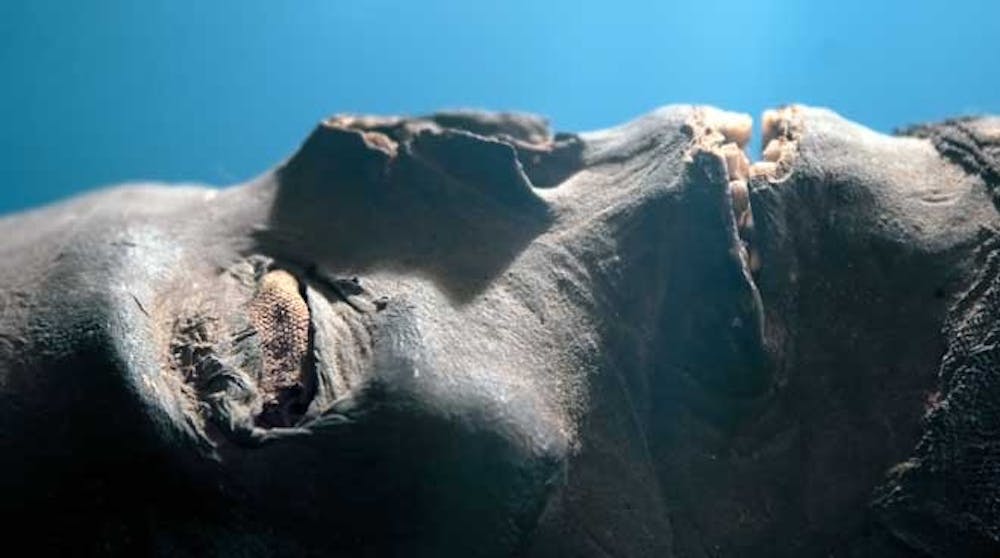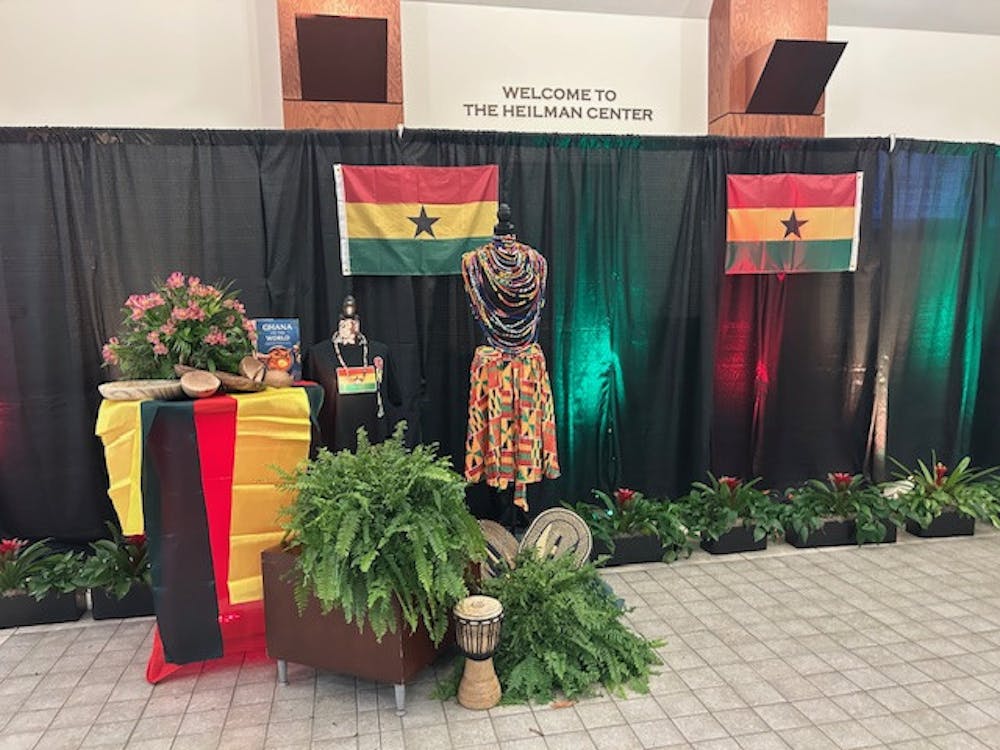Few students are aware that a 2,700-year-old Egyptian mummy has been the University of Richmond's property for 133 years.
The mummy, Tchai-Ameni-Newit, and her sarcophagus are on public display in the Classical Studies Department's Stuart L. Wheeler Gallery of the Ancient World in North Court Academic Building. The dimly lit room, silent except for the hum of the ventilation system, is home to a number of other Greek and Roman antiquities and modern replicas.
Of the items in the gallery, the mummy is most prominent. She lies in a glass-sided drawer that pulls out from the left wall, and her sarcophagus stands in a large glass case directly above her.
According to the Classical Studies Department's Web site, the university acquired Tchai-Ameni-Newit in 1876, when Jabez Lamar Monroe Curry, a professor and trustee of Richmond College, brought her back from an excursion to Egypt. Curry bought the mummy in Egypt from an American who said it had once belonged to the Prince of Wales.
This part of the history has raised some skepticism over whether the mummy actually belongs to the sarcophagus, said Elizabeth Baughan, assistant professor of classics and archaeology at Richmond.
The description of the American who sold the mummy to Curry resembles Edwin Smith, Baughan said. Smith was part of a team that supposedly excavated 30 mummies one day in 1875 and presented them to the Prince of Wales, she said.
"The question is, how likely it is that 30 mummies were excavated at one time and in one day?" Baugh said.
"Was it kind of a set up to please the Prince of Wales when he visited and, if so, were they mixing mummies with sarcophagi that were more intact?"
Other than these circumstances of the find, there was no reason to question the association of the mummy and the sarcophagus, Baughan said.
"It's the sarcophagus for a woman and the mummy is female, so it works," she said.
Before the mummy arrived at Richmond, it made an appearance at the 1876 Centennial Exposition in Philadelphia, Baughan said. Afterwards, Tchai-Ameni-Newit was taken to the Richmond College museum in downtown Richmond.
According to the Web site, when the college relocated to the city's Westhampton section in 1914, the mummy was without a proper museum space and put in the Biology Museum of Maryland Hall. In 1977 it was moved yet again to a storage closet in North Court where it would remain until Stuart Wheeler, associate professor of cultural studies at the time, oversaw construction of the Gallery of the Ancient World.
Enjoy what you're reading?
Signup for our newsletter
"I guess I'm sort of the de facto curator of the gallery as the one archaeologist in the department," said Baughan, who has worked closely with the gallery. "This is my second year so I'm still getting to know the mummy, too."
The gallery does not get a lot of visitors, Baughan said.
"The visitors, it does get to be part of the community," she said. "When I hear people come in it's often people who have heard about it and live nearby.
"School groups, elementary- and middle-school-aged kids will sometimes come."
Baughan thought the gallery could be better marked on signs and campus maps in order to attract more visitors, she said.
Other antiquities in the gallery include pages from the Nuremberg Chronicle, a kind of encyclopedia of the world, from 1493, and a copy of Ovid's Fasti, an extensive treatment of the Roman calendar, from 1526. There are two other fragments of sarcophagi that don't belong to Tchai-Ameni-Newit. One depicts a deceased person before the Egyptian god Osiris and is estimated to have been from between 1557 B.C. and 1304 B.C. An ostrich egg believed to have been an Egyptian tomb offering and a small statue of an Egyptian Sphinx from the second millennium B.C. are also on display.
While the gallery has its share of antiquities, it also has a number of replicas that can be used in the classroom as well as put on display. Wheeler, Baughan's predecessor and the gallery's founder, acquired the Greek pottery replicas as a study collection, Baughan said.
These replicas can be passed around a room and analyzed for technique and style, she said. Baughan has used the replicas in both her Introduction to Archaeology and Greek Art and Archaeology courses, she said. The department was able to expand the gallery and purchase the replicas after a generous donation from Gertrude Howland, Baughan said.
If the department were to acquire any more pieces for the gallery, Baughan said she thought they would have to be more modern replicas because of the ethics now involved in the antiquities market.
"Since 1970, museums and collectors have been starting to become more aware of the ethical issues and countries like Egypt and Italy now have patrimony laws, which vest ownership of all the antiquities found in their ground," she said. "The only way you can buy antiquities now without stepping into that questionable ethical territory is to buy things that have a documented history prior to 1970."
Unfortunately, these "clean" pieces are very expensive and probably out of the department's price range, Baughan said.
Since Tchai-Ameni-Newit was brought back to the United States so long ago, she is not subject to Egyptian patrimony laws, Baughan said. So far the mummy has been given the best treatment of any of the items in the gallery, she said.
Wheeler had the mummy x-rayed in 1976 at the Naval Ballistics Laboratory in Indian Head, Md. These x-rays revealed, among other things, that the mummy was between 30 and 40 years old, that she had no scars from childbirth and that she had a slight case of arthritis.
Wheeler had a CAT scan performed to analyze the mummy's bone structure as well, Baughan said. Egyptologists have also come to translate the hieroglyphic text on the sarcophagus, she said, deciphering that her father was named Nesy Amun and her mother was named Ru Ru or Lu Lu.
To care for the mummy, the department just has to keep an eye on the gallery's humidity, Baughan said. Lately they have also been keeping the light off in Tchai-Ameni-Newit's space, she said.
"We'll turn it on if a school group or something comes to see her but a conscious decision was made, I think unanimously by the department, just to leave the light off most days; not to showcase her so much.
"It was just a way to deal with some of our feelings about whether it's right to have a mummy on display; somebody that was buried at a particular time for a particular reason. Her loved ones went to great effort to have her mummified for eternity and here she is in our gallery."
It brings up the question of ownership of mummies, Baughan said. "One could argue that [Tchai-Ameni-Newit] should be the property of Egypt and that it should be sent back because that's where it was found," she said. "Others would say mummies in Egypt are a dime a dozen, so isn't it doing more good here where it can enlighten Richmond students and the Richmond community about ancient practices of mummification and so on?
"You could look at it either way."
Dayle Wood, a Westhampton College sophomore, is taking Cultural Property, Ethics and Law with Baughan and is one of four independent study students working to update the gallery, she said. She has been doing research on the ethical issues of mummy ownership for the cultural property class, she said.
Wood thought the mummy was a wonderful thing for the university to have but didn't see how it was very beneficial at this point, she said.
"Nobody is really getting any use out of it," she said. "I don't really know what the right solution is, I mean, unless you put it in the entrance to the library or something. Part of me just doesn't really know how interested people are."
Contact staff writer Guv Callahan at
Support independent student media
You can make a tax-deductible donation by clicking the button below, which takes you to our secure PayPal account. The page is set up to receive contributions in whatever amount you designate. We look forward to using the money we raise to further our mission of providing honest and accurate information to students, faculty, staff, alumni and others in the general public.
Donate Now



